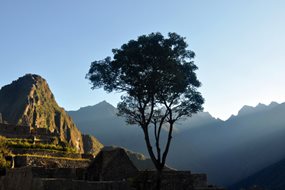
Nestled between Cuzco and the lofty heights of Machu Picchu is Peru’s Sacred Valley, often referred to as the Urubamba Valley, from the name of its primary waterway, the Urubamba river. This stunning valley lies at the heart of a uniquely fertile geographic and climactic stretch of land in the high altitude of the Andes. Archeologists and scholars believe that the strategically located valley and river played a vital role in the growth and development of the Inca into a complex and sophisticated society that built a mighty empire.
Geographic evidence suggests that the Inca were forced into the Sacred Valley after a widespread drought devastated the neighboring lowlands. The Sacred Valley not only protected the Inca, but also provided a route into the jungle, and foraging opportunities for fruits and other crops. As temperatures gradually warmed over the next decades, the Inca refined a sophisticated system of irrigated terraces to cultivate corn, cocoa, potatoes, and other key staples. Salt was also harvested through similarly terraced evaporation pools, still in active use today at Maras. With agricultural success came surplus and Incan society gradually became multi-faceted: urbanization, trade, and elaborate social hierarchies came to the Sacred Valley, as did a highly developed belief system, rooted in cosmology. The topography of the Sacred Valley was an integral part of this Inca’s religion, particularly the Urubamba R, thought to be the earthly counterpart to the Milky Way. Strategic, fertile, and powerful, the Inca came to regard the Sacred Valley as the source of their strength and power.
The waning of the Inca Empire did not diminish the appeal Sacred Valley. Even as the Inca’s sacred sights and monuments began to recede — slowly but inexorably — back into the mountains and peaks from which they had been hewn, Spanish settlers established vibrant Colonial towns and settlements, successfully integrating indigenous peoples and their traditions with the newer settlers.
This fusion of cultures is still extant today in the colorful fortress town of Ollantaytambo and the market town of Pisac, where the ancient crafts of the Sacred Valley are still practiced by today’s decedents of the Inca.
Walk through the Sacred Valley on Alexander + Roberts’ new
Walking in the Andes with our own local Andean Trip Leader, Ladisalo Mansilla.